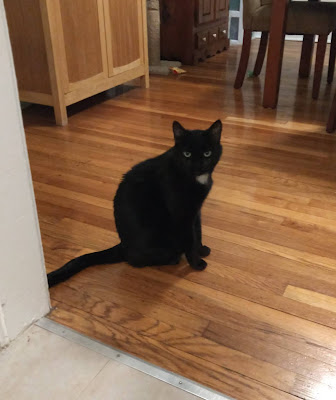If you have a cat or cats in your life, you've undoubtedly noticed that sometimes a cat will sit with its tail wrapped against one side of its body. For example, here is a picture of my cat Eponine, at one year old, with her tail against the left side of her body:
I realized that I did not know whether, when cats do this, they have a side preference. If I observed Eponine doing this many times, would her tail consistently be on her left side? Would it usually be on her left side but sometimes on her right? Would it usually be on her right side? Would it be essentially random?
Since I was spending a large amount of time at home, I thought hey, it would be fun to do a study to try to answer this question!
Study subjects:
Eponine, 13 year old (at time of study) female
Gavroche (hereafter referred to by his nickname Gavvy), 4 year old male
Graystripe, 3 or 4 (exact age not known because he was already fully grown when I adopted him as a stray) year old male
To carry out the study, I simply observed my cats in their normal day-to-day lives and whenever I saw one sitting with its tail wrapped against one side of its body, I recorded the side with a tally mark. There were a few criteria for which observations did and did not count. To be included, the cat had to be sitting on a flat surface and with its body in a roughly symmetrical manner other than the tail, and with the tail all the way against the side of the body.
So here are a couple examples of observations that would not count.
Here Graystripe is lying on his side, so although his tail is wrapped against his body, this doesn't count because he's not sitting with his body in a symmetrical manner.
Here Gavvy is sitting with his body roughly symmetrical. His tail is pointing toward his right side, but it's not wrapped against the side of his body so it doesn't count.
On the other hand, I did not distinguish between cats sitting upright and sitting "like a loaf," and counted either as long as their bodies were roughly symmetrical and their tails were against one side of their bodies.
Sitting upright with tail against right side of body - this counts.
Sitting "like a loaf." Tail is not visible in this picture but I believe was against right side of body; assuming that is accurate, this would count.
The tendencies of cats to sit upright vs. "like a loaf" were not measured in this study but could be an interesting topic for future research!
I did not specify an amount of time over which to carry out the study but simply recorded every observation meeting the criteria until I had enough to be confident about the results. Here is the record of my observations:
The first thing that jumps out is Eponine sat with her tail wrapped against her body a lot more often than the other two cats. This makes me wonder if the tendency to do this might be a female vs. male thing, but obviously I couldn't even attempt to draw any conclusions about that without studying more cats.
The next thing that jumps out is Gavvy wrapped his tail on his right side a lot more often than his left whereas the other two cats had close to equal numbers by side. Here is a graph of the total numbers by side for each cat:
(The error bars on the graph show the range that the actual percentages would fall within 95% of the time if the observations were unbiased. Source for how to calculate confidence intervals for proportions if anyone is interested.)
Using a binomial probability calculator, for Eponine, if she actually has no side preference - that is, the actual probability for each side is 50% - by random chance there would be a 26.5% chance that at least 66 (the observed number) out of the total 124 observations would be on the left side. Or, there would be a 53% chance that at least 66 out of 124 would be on one of the two sides (26.5% chance for left plus 26.5% chance for right). In other words, the degree to which Eponine's results diverged from a 50/50, no preference outcome is easily consistent with random chance and we do not have evidence that Eponine has a side preference.
For Graystripe, the observed results were exactly 50% on each side - 22 left and 22 right. So clearly for Graystripe we also do not have evidence for a side preference. (But note the larger confidence intervals for Graystripe than for Eponine, which is due to fewer observations having been made - although we don't have evidence for a side preference, we haven't proven that he has no side preference. But if he does, it's not a dramatic one.)
For Gavvy, the outcome is quite different. There is only a 0.024% chance that with no side preference, he would have only 8 or fewer "left" outcomes out of 38 total, or 0.048% chance to have 8 or fewer outcomes be on one of the two sides. The chances of obtaining results like those for Gavvy if he, in reality, had no side preference are smaller than one in two thousand. For Gavvy, we have strong evidence that he prefers to wrap his tail on the right side of his body.
Before I did this study, I genuinely had no idea what the answer to my question was. After doing the study, I can conclude that some cats do have a strong preference toward wrapping their tail on one side of their body, and some cats do not. I learned something about the world! Isn't science great? 😸











No comments:
Post a Comment